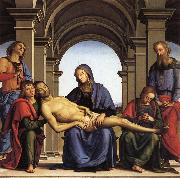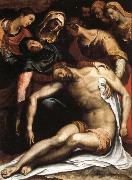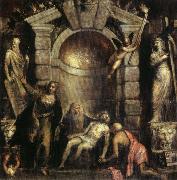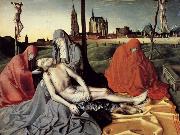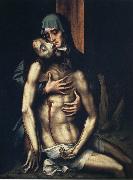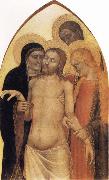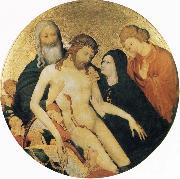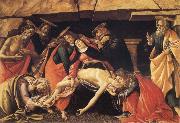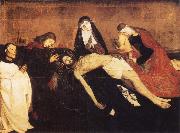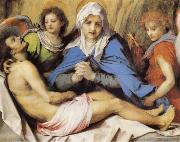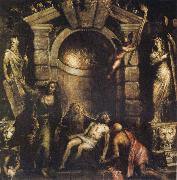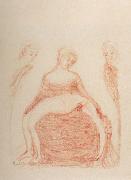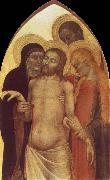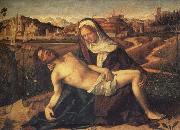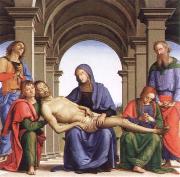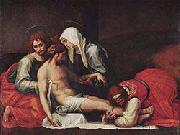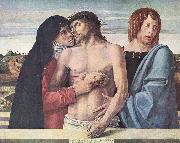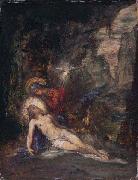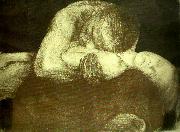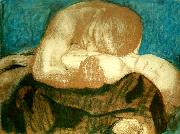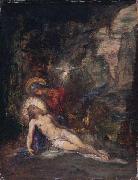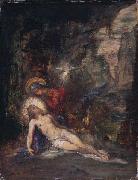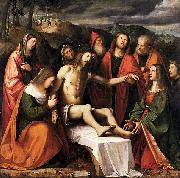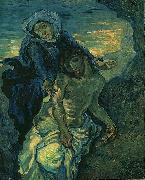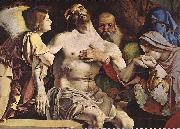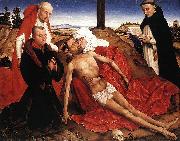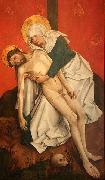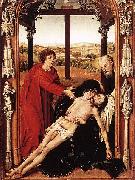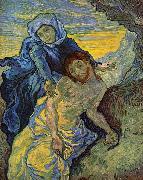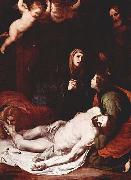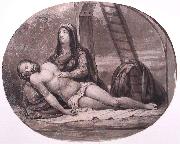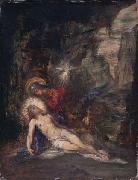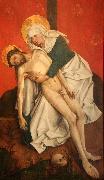Wholesale Oil Painting No Minimum |
|||||||||||
|
|
|||||||||||

|
|||||||||||
|
|
|
||||||||
Giovanni BelliniItalian High Renaissance Painter, ca.1430-1516 (b ?1431-6; d Venice, 29 Nov 1516). Painter and draughtsman, son of (1) Jacopo Bellini. Although the professional needs of his family background may have encouraged him to specialize at an early date in devotional painting, by the 1480s he had become a leading master in all types of painting practised in 15th-century Venice. Later, towards the end of his long life, he added the new genres of mythological painting and secular allegory to his repertory of subject-matter. His increasing dominance of Venetian art led to an enormous expansion of his workshop after c. 1490; and this provided the training-ground not only for his numerous shop-hands and imitators (generically known as Belliniani) but probably also for a number of major Venetian painters of the next generation. Throughout his career, Giovanni showed an extraordinary capacity for absorbing a wide range of artistic influences, both from within Venetian tradition and from outside. He also oversaw a technical revolution in the art of painting, involving the gradual abandonment of the traditional Italian use of egg tempera in favour of the technique of oil painting pioneered in the Netherlands. It was thanks to Giovanni Bellini that the Venetian school of painting was transformed during the later 15th century from one mainly of local significance to one with an international reputation. He thus set the stage for the triumphs of Venetian painting in the 16th century and for the central contribution that Venice was to make to the history of European art. |
||||||||
|
|
||||||||
Pieta
Pieta Painting ID:: 56 |
Brera Gallery, Milan Brera Gallery, Milan |
|||||||
|
|
||||||||
Andrea del Sartob.July 16, 1486, Florence d.Sept. 28, 1530, Florence Italian Andrea del Sarto Galleries Andrea del Sarto (1486 ?C 1531) was an Italian painter from Florence, whose career flourished during the High Renaissance and early-Mannerism. Though highly regarded by his contemporaries as an artist "senza errori" (i.e., faultless), he is overshadowed now by equally talented contemporaries like Raphael. Andrea fell in love with Lucrezia (del Fede), wife of a hatter named Carlo, of Recanati; the hatter dying opportunely, Andrea married her on 26 December 1512. She has come down to us in many a picture of her lover-husband, who constantly painted her as a Madonna and otherwise; even in painting other women he made them resemble Lucrezia. She was less gently handled by Giorgio Vasari, a pupil of Andrea, who describes her as faithless, jealous, and vixenish with the apprentices; her offstage character permeates Robert Browning's poem-monologue "Andrea del Sarto called the 'faultless painter'" (1855) . He dwelt in Florence throughout the memorable siege of 1529, which was soon followed by an infectious pestilence. He caught the malady, struggled against it with little or no tending from his wife, who held aloof, and he died, no one knowing much about it at the moment, on 22 January 1531, at the comparatively early age of forty-three. He was buried unceremoniously in the church of the Servites. His wife survived her husband by forty years. A number of paintings are considered to be self-portraits. One is in the National Gallery, London, an admirable half-figure, purchased in 1862. Another is at Alnwick Castle, a young man about twenty years, with his elbow on a table. Another youthful portrait is in the Uffizi Gallery, and the Pitti Palace contains more than one. |
||||||||
|
|
||||||||
|
|
Pieta
Pieta Painting ID:: 3244 |
1519-20
Art History Museum, Vienna 1519-20 Art History Museum, Vienna |
||||||
|
|
||||||||
Rosso FiorentinoItalian Mannerist Painter, ca.1495-1540 Born in Florence Italy with the red hair that gave him his nickname, Rosso first trained in the studio of Andrea del Sarto alongside his contemporary, Pontormo. In late 1523, Rosso moved to Rome, where he was exposed to the works of Michelangelo, Raphael, and other Renaissance artists, resulting in the realignment of his artistic style. Fleeing Rome after the Sacking of 1527, Rosso eventually went to France where he secured a position at the court of Francis I in 1530, remaining there until his death. Together with Francesco Primaticcio, Rosso was one of the leading artists to work at the Chateau Fontainebleau as part of the "First School of Fontainebleau", spending much of his life there. Following his death in 1540 (which, according to an unsubstantiated claim by Vasari, was a suicide ), Francesco Primaticcio took charge of the artistic direction at Fontainebleau. Rosso's reputation, along those of other stylized late Renaissance Florentines, was long out of favour in comparison to other more naturalistic and graceful contemporaries, but has revived considerably in recent decades. That his masterpiece is in a small city, away from the tourist track, was a factor in this, especially before the arrival of photography. His poses are certainly contorted, and his figures often appear haggard and thin, but his work has considerable power. |
||||||||
|
|
||||||||
|
|
Pieta
Pieta Painting ID:: 3622 |
1530-35
Musee du Louvre, Paris 1530-35 Musee du Louvre, Paris |
||||||
|
|
||||||||
ROMANINOItalian painter, Brescian school (b. ca. 1484, Brescia, d. ca. 1559, Brescia). |
||||||||
|
|
||||||||
|
|
Pieta
Pieta Painting ID:: 8947 |
1510
Oil on panel, 183 x 185) cm
Gallerie dell'Accademia, Venice 1510 Oil on panel, 183 x 185) cm Gallerie dell'Accademia, Venice |
||||||
|
|
||||||||
Giovanni BelliniItalian High Renaissance Painter, ca.1430-1516 (b ?1431-6; d Venice, 29 Nov 1516). Painter and draughtsman, son of (1) Jacopo Bellini. Although the professional needs of his family background may have encouraged him to specialize at an early date in devotional painting, by the 1480s he had become a leading master in all types of painting practised in 15th-century Venice. Later, towards the end of his long life, he added the new genres of mythological painting and secular allegory to his repertory of subject-matter. His increasing dominance of Venetian art led to an enormous expansion of his workshop after c. 1490; and this provided the training-ground not only for his numerous shop-hands and imitators (generically known as Belliniani) but probably also for a number of major Venetian painters of the next generation. Throughout his career, Giovanni showed an extraordinary capacity for absorbing a wide range of artistic influences, both from within Venetian tradition and from outside. He also oversaw a technical revolution in the art of painting, involving the gradual abandonment of the traditional Italian use of egg tempera in favour of the technique of oil painting pioneered in the Netherlands. It was thanks to Giovanni Bellini that the Venetian school of painting was transformed during the later 15th century from one mainly of local significance to one with an international reputation. He thus set the stage for the triumphs of Venetian painting in the 16th century and for the central contribution that Venice was to make to the history of European art. |
||||||||
|
|
||||||||
|
|
Pieta
Pieta Painting ID:: 10063 |
1455-60
Wood panel,
52x42 cm.
Academia Carrara
Bergamo, Italy 1455-60 Wood panel, 52x42 cm. Academia Carrara Bergamo, Italy |
||||||
|
|
||||||||
LE BRUN, CharlesFrench painter (b. 1619, Paris, d. 1690, Paris) French painter and designer. He dominated 17th-century French painting as no other artist; it was not until over a century later, during the predominance of Jacques-Louis David, that artistic authority was again so concentrated in one man. Under the protection of a succession of important political figures, including Chancellor Pierre S?guier, Cardinal Richelieu and Nicolas Fouquet, Le Brun created a series of masterpieces of history and religious painting. For Louis XIV and his chief minister Jean-Baptiste Colbert he executed his greatest work, the royal palace of Versailles: an almost perfect ensemble of architecture, decoration and landscape. After Colbert's death in 1683, he was no longer able to count on prestigious commissions |
||||||||
|
|
||||||||
|
|
Pieta
Pieta Painting ID:: 7827 |
1643-45
Oil on canvas, 146 x 222 cm
Mus??e du Louvre, Paris 1643-45 Oil on canvas, 146 x 222 cm Mus??e du Louvre, Paris |
||||||
|
|
||||||||
Gustave MoreauFrench 1826-1898 Moreau's main focus was the illustration of biblical and mythological figures. As a painter of literary ideas rather than visual images, he appealed to the imaginations of some Symbolist writers and artists, who saw him as a precursor to their movement. His father, Louis Jean Marie Moreau, was an architect, who recognized his talent. His mother was Adele Pauline des Moutiers. Moreau studied under François-Édouard Picot and became a friend of Th??odore Chass??riau, whose work strongly influenced his own. Moreau carried on a deeply personal 25-year relationship, possibly romantic, with Adelaide-Alexandrine Dureux, a woman whom he drew several times.[1] His first painting was a Piet?? which is now located in the cathedral at Angoul??me. He showed A Scene from the Song of Songs and The Death of Darius in the Salon of 1853. In 1853 he contributed Athenians with the Minotaur and Moses Putting Off his Sandals within Sight of the Promised Land to the Great Exhibition. Oedipus and the Sphinx, one of his first symbolist paintings, was exhibited at the Salon of 1864. Over his lifetime, he produced over 8,000 paintings, watercolors and drawings, many of which are on display in Paris' Mus??e national Gustave Moreau at 14, rue de la Rochefoucauld (IXe arrondissement). The museum is in his former workshop, and was opened to the public in 1903. Andr?? Breton famously used to "haunt" the museum and regarded Moreau as a precursor to Surrealism. He had become a professor at Paris' École des Beaux-Arts in 1891 and counted among his many students the fauvist painters, Henri Matisse and Georges Rouault. Moreau is buried in Paris' Cimeti??re de Montmartre. In Alan Moore's graphic novel, The League of Extraordinary Gentlemen, it is implied that he was a nephew of Doctor Moreau, and he based a few of his paintings on the Doctor's creations. |
||||||||
|
|
||||||||
|
|
Pieta
Pieta Painting ID:: 19530 |
1854
oil on canvas
Museum of Fine Arts, Gifu. 1854 oil on canvas Museum of Fine Arts, Gifu. |
||||||
|
|
||||||||
Jacob JordaensFlemish Baroque Era Painter, 1593-1678 Jacob Jordeans was born on May 19, 1593, the first of eleven children, to the wealthy linen merchant Jacob Jordaens Sr. and Barbara van Wolschaten in Antwerp. Little is known about Jordaens's early education. It can be assumed that he received the advantages of the education usually provided for children of his social class. This assumption is supported by his clear handwriting, his competence in French and in his knowledge of mythology. Jordaens familiarity with biblical subjects is evident in his many religious paintings, and his personal interaction with the Bible was strengthened by his later conversion from Catholicism to Protestantism. Like Rubens, he studied under Adam van Noort, who was his only teacher. During this time Jordaens lived in Van Noort's house and became very close to the rest of the family. After eight years of training with Van Noort, he enrolled in the Guild of St. Luke as a "waterscilder", or watercolor artist. This medium was often used for preparing tapestry cartoons in the seventeenth century. although examples of his earliest watercolor works are no longer extant. In the same year as his entry into the guild, 1616, he married his teacher's eldest daughter, Anna Catharina van Noort, with whom he had three children. In 1618, Jordaens bought a house in Hoogstraat (the area in Antwerp that he grew up in). He would then later buy the adjoining house to expand his household and workspace in 1639, mimicking Rubens's house built two decades earlier. He lived and worked here until his death in 1678. Jordaens never made the traditional trip to Italy to study classical and Renaissance art. Despite this, he made many efforts to study prints or works of Italian masters available in northern Europe. For example, Jordaens is known to have studied Titian, Veronese, Caravaggio, and Bassano, either through prints, copies or originals (such as Caravaggio's Madonna of the Rosary). His work, however, betrays local traditions, especially the genre traditions of Pieter Bruegel the Elder, in honestly depicting Flemish life with authenticity and showing common people in the act of celebratory expressions of life. His commissions frequently came from wealthy local Flemish patrons and clergy, although later in his career he worked for courts and governments across Europe. Besides a large output of monumental oil paintings he was a prolific tapestry designer, a career that reflects his early training as a "watercolor" painter. Jordaens' importance can also be seen by his number of pupils; the Guild of St. Luke records fifteen official pupils from 1621 to 1667, but six others were recorded as pupils in court documents and not the Guild records, so it is probable that he had more students than officially recorded. Among them were his cousin and his son Jacob. Like Rubens and other artists at that time, Jordaens' studio relied on his assistants and pupils in the production of his paintings. Not many of these pupils went on to fame themselves,however a position in Jordaens's studio was highly desirable for young artists from across Europe. |
||||||||
|
|
||||||||
|
|
Pieta
Pieta Painting ID:: 28717 |
mk61
Oil on canvas
221x169cm
mk61 Oil on canvas 221x169cm |
||||||
|
|
||||||||
VERONESE (Paolo Caliari)Italian Mannerist Painter, ca.1528-1588 |
||||||||
|
|
||||||||
|
|
Pieta
Pieta Painting ID:: 29299 |
Oil on canvas, 147 x 115 cm Oil on canvas, 147 x 115 cm |
||||||
|
|
||||||||
PERUGINO, PietroItalian painter, Umbrian school (b. 1450, Citta della Pieve, d. 1523, Perugia). Italian painter and draughtsman. He was active in Perugia, Florence and Rome in the late 15th century and early 16th. Although he is now known mainly as the teacher of Raphael, he made a significant contribution to the development of painting from the style of the Early Renaissance to the High Renaissance. The compositional model he introduced, combining the Florentine figural style with an Umbrian use of structure and space, |
||||||||
|
|
||||||||
|
|
Pieta
Pieta Painting ID:: 29786 |
mk67
Oil on panel
66 1/8x69 5/16in
Uffizi,Gallery
mk67 Oil on panel 66 1/8x69 5/16in Uffizi,Gallery |
||||||
|
|
||||||||
Stefano PieriItalian , Florentine artist , (1542-1629) |
||||||||
|
|
||||||||
|
|
Pieta
Pieta Painting ID:: 29876 |
mk67
Oil on panel
67 5/16x50in
Accademia,Gallery
mk67 Oil on panel 67 5/16x50in Accademia,Gallery |
||||||
|
|
||||||||
TitianItalian High Renaissance Painter, ca.1485-1576 Italian painter active in Venice. As a young man he was taught by the Bellini family and worked closely with Giorgione. His early works are so similar in style to Giorgione's as to be indistinguishable, but soon after Giorgione's early death Titian established himself as the leading painter of the Republic of Venice. Among his most important religious paintings is the revolutionary and monumental Assumption (1516 ?C 18) for Santa Maria dei Frari, in which the Virgin ascends to heaven in a blaze of colour accompanied by a semicircle of angels. Titian was also interested in mythological themes, and his many depictions of Venus display his work's sheer beauty and inherent eroticism. Bacchus and Ariadne (1520 ?C 23), with its pagan abandon, is one of the greatest works of Renaissance art. Titian was sought after for his psychologically penetrating portraits, which include portrayals of leading Italian aristocrats, religious figures, and Emperor Charles V. He reached the height of his powers in The Rape of Europa (c. 1559 ?C 62), one of several paintings done for Philip II of Spain. He was recognized as supremely gifted in his lifetime, and his reputation has never declined. |
||||||||
|
|
||||||||
|
|
Pieta
Pieta Painting ID:: 30522 |
mk68
Oil on canva
11'6 1/2"x11" 5"
Venice,Accademai Gallery
1576
Italy
mk68 Oil on canva 11'6 1/2"x11" 5" Venice,Accademai Gallery 1576 Italy |
||||||
|
|
||||||||
WITZ, Konradb. cca 1400, Rottweil, d. ca. 1445, Basel. German-born painter from Rottweil in Swabia, active in Switzerland. German painter. One of the great innovators in northern European painting, he turned away from the lyricism of the preceding generation of German painters. His sturdy, monumental figures give a strong impression of their physical presence, gestures are dignified and the colours strong and simple. Even scenes with several figures are strangely undramatic and static. The surface appearance of materials, especially metals and stone, is intensely observed and recorded with an almost naive precision. Powerful cast shadows help to define the spatial relationships between objects. His fresh approach to the natural world reflects that of the Netherlandish painters: the Master of Fl?malle and the van Eycks. He need not, however, have trained in the Netherlands or in Burgundy as knowledge of their style could have been gained in Basle. He remained, however, untouched by the anecdotal quality present in their art, |
||||||||
|
|
||||||||
|
|
Pieta
Pieta Painting ID:: 31731 |
mk76
Date unknown
Tempera on panel
13 1/8x17 1/2in
mk76 Date unknown Tempera on panel 13 1/8x17 1/2in |
||||||
|
|
||||||||
MORALES, Luis deSpanish Mannerist Painter, ca.1520-1586 Spanish painter. The origins of his highly individual style are complex. His meticulous technique and the prominent echoes of the style and forms of Leonardo da Vinci and Raphael indicate the formative influence of Italianizing Flemish painters. This accords with Palomino's statement that Morales was trained in Seville by the Flemish Mannerist painter Peeter de Kempeneer (known in Spain as Pedro de Campara), who is recorded in Spain from 1537. It has been suggested that Morales visited Italy c. 1540, but this seems most unlikely. |
||||||||
|
|
||||||||
|
|
Pieta
Pieta Painting ID:: 32867 |
mk84
1560-70
Madrid,
Real Academia de Bellas Artes
Panel
126x98cm
mk84 1560-70 Madrid, Real Academia de Bellas Artes Panel 126x98cm |
||||||
|
|
||||||||
GIOVANNI DA MILANOItalian Gothic Era Painter, active 1350-1369 |
||||||||
|
|
||||||||
|
|
Pieta
Pieta Painting ID:: 33331 |
mk86
1365
Tempera on wood
122x58cm
Florence
Galleria dell'Accademia
mk86 1365 Tempera on wood 122x58cm Florence Galleria dell'Accademia |
||||||
|
|
||||||||
Jean MalouelNiemegan before 1370-Dijon 1415 |
||||||||
|
|
||||||||
|
|
Pieta
Pieta Painting ID:: 33355 |
mk86
c.1400
Tempera on wood,diameter
Paris,Musee National du Louvre
mk86 c.1400 Tempera on wood,diameter Paris,Musee National du Louvre |
||||||
|
|
||||||||
Sandro BotticelliItalian Early Renaissance Painter, 1445-1510 Italian painter and draughtsman. In his lifetime he was one of the most esteemed painters in Italy, enjoying the patronage of the leading families of Florence, in particular the Medici and their banking clients. He was summoned to take part in the decoration of the Sistine Chapel in Rome, was highly commended by diplomatic agents to Ludovico Sforza in Milan and Isabella d Este in Mantua and also received enthusiastic praise from the famous mathematician Luca Pacioli and the humanist poet Ugolino Verino. By the time of his death, however, Botticelli s reputation was already waning. He was overshadowed first by the advent of what Vasari called the maniera devota, a new style by Perugino, Francesco Francia and the young Raphael, whose new and humanly affective sentiment, infused atmospheric effects and sweet colourism took Italy by storm; he was then eclipsed with the establishment immediately afterwards of the High Renaissance style, which Vasari called the modern manner, in the paintings of Michelangelo and the mature works of Raphael in the Vatican. From that time his name virtually disappeared until the reassessment of his reputation that gathered momentum in the 1890s |
||||||||
|
|
||||||||
|
|
Pieta
Pieta Painting ID:: 33391 |
mk86
after1490
Tempera on wood
140x207cm
Munich,Bayerische Staatsgemaldesammlungen,Alte Pinakothek
mk86 after1490 Tempera on wood 140x207cm Munich,Bayerische Staatsgemaldesammlungen,Alte Pinakothek |
||||||
|
|
||||||||
Enguerrand Quartonactive in Provence 1444-1466 |
||||||||
|
|
||||||||
|
|
Pieta
Pieta Painting ID:: 33444 |
mk86
c.1460
Tempera on panel
162x217cm
Paris,Musee National du Louvre
mk86 c.1460 Tempera on panel 162x217cm Paris,Musee National du Louvre |
||||||
|
|
||||||||
Andrea del Sartob.July 16, 1486, Florence d.Sept. 28, 1530, Florence Italian Andrea del Sarto Galleries Andrea del Sarto (1486 ?C 1531) was an Italian painter from Florence, whose career flourished during the High Renaissance and early-Mannerism. Though highly regarded by his contemporaries as an artist "senza errori" (i.e., faultless), he is overshadowed now by equally talented contemporaries like Raphael. Andrea fell in love with Lucrezia (del Fede), wife of a hatter named Carlo, of Recanati; the hatter dying opportunely, Andrea married her on 26 December 1512. She has come down to us in many a picture of her lover-husband, who constantly painted her as a Madonna and otherwise; even in painting other women he made them resemble Lucrezia. She was less gently handled by Giorgio Vasari, a pupil of Andrea, who describes her as faithless, jealous, and vixenish with the apprentices; her offstage character permeates Robert Browning's poem-monologue "Andrea del Sarto called the 'faultless painter'" (1855) . He dwelt in Florence throughout the memorable siege of 1529, which was soon followed by an infectious pestilence. He caught the malady, struggled against it with little or no tending from his wife, who held aloof, and he died, no one knowing much about it at the moment, on 22 January 1531, at the comparatively early age of forty-three. He was buried unceremoniously in the church of the Servites. His wife survived her husband by forty years. A number of paintings are considered to be self-portraits. One is in the National Gallery, London, an admirable half-figure, purchased in 1862. Another is at Alnwick Castle, a young man about twenty years, with his elbow on a table. Another youthful portrait is in the Uffizi Gallery, and the Pitti Palace contains more than one. |
||||||||
|
|
||||||||
|
|
Pieta
Pieta Painting ID:: 33475 |
mk86
c.1519/20
Oil on wood
99x120cm
Vienna,Kunsthistorisches Museum
mk86 c.1519/20 Oil on wood 99x120cm Vienna,Kunsthistorisches Museum |
||||||
|
|
||||||||
TitianItalian High Renaissance Painter, ca.1485-1576 Italian painter active in Venice. As a young man he was taught by the Bellini family and worked closely with Giorgione. His early works are so similar in style to Giorgione's as to be indistinguishable, but soon after Giorgione's early death Titian established himself as the leading painter of the Republic of Venice. Among his most important religious paintings is the revolutionary and monumental Assumption (1516 ?C 18) for Santa Maria dei Frari, in which the Virgin ascends to heaven in a blaze of colour accompanied by a semicircle of angels. Titian was also interested in mythological themes, and his many depictions of Venus display his work's sheer beauty and inherent eroticism. Bacchus and Ariadne (1520 ?C 23), with its pagan abandon, is one of the greatest works of Renaissance art. Titian was sought after for his psychologically penetrating portraits, which include portrayals of leading Italian aristocrats, religious figures, and Emperor Charles V. He reached the height of his powers in The Rape of Europa (c. 1559 ?C 62), one of several paintings done for Philip II of Spain. He was recognized as supremely gifted in his lifetime, and his reputation has never declined. |
||||||||
|
|
||||||||
|
|
Pieta
Pieta Painting ID:: 33494 |
mk86
c.1573-1576
Oil on canvas
351x389cm
Venice,Galleria dell'Accademia
mk86 c.1573-1576 Oil on canvas 351x389cm Venice,Galleria dell'Accademia |
||||||
|
|
||||||||
James EnsorBelgian 1860-1949 Belgian painter, printmaker and draughtsman. No single label adequately describes the visionary work produced by Ensor between 1880 and 1900, his most productive period. His pictures from that time have both Symbolist and Realist aspects, and in spite of his dismissal of the Impressionists as superficial daubers he was profoundly concerned with the effects of light. His imagery and technical procedures anticipated the colouristic brilliance and violent impact of Fauvism and German Expressionism and the psychological fantasies of Surrealism. Ensor most memorable and influential work was almost exclusively produced before 1900, but he was largely unrecognized before the 1920s in his own country. His work was highly influential in Germany, however: Emil Nolde visited him in 1911, and was influenced by his use of masks; Paul Klee mentions him admiringly in his diaries; Erich Heckel came to see him in the middle of the war and painted his portrait (1930; Cologne, Wallraf-Richartz-Mus.); Alfred Kubin owned several of his prints, while Marc Chagall and George Grosz also adapted certain elements from Ensor. All the artists of the Cobra group saw him as a master. He influenced many Belgian artists including Leon Spilliaert, Rik Wouters, Constant Permeke, Frits van den Berghe, Paul Delvaux and Pierre Alechinsky. |
||||||||
|
|
||||||||
|
|
Pieta
Pieta Painting ID:: 37448 |
mk126
mk126 |
||||||
|
|
||||||||
GIOVANNI DA MILANOItalian Gothic Era Painter, active 1350-1369 |
||||||||
|
|
||||||||
|
|
Pieta
Pieta Painting ID:: 40150 |
mk156
1365
Tempera on panel
122x58cm
mk156 1365 Tempera on panel 122x58cm |
||||||
|
|
||||||||
Paolo Veronese1528-1588 Paolo Veronese Galleries Italian painter and draughtsman. With Titian and Tintoretto he makes up the triumvirate of great painters of the late Renaissance in Venice. He is known as a supreme colourist and for his illusionistic decorations in both fresco and oil. His large paintings of biblical feasts executed for the refectories of monasteries in Venice and Verona are especially celebrated. He also produced many altarpieces, history and mythological paintings and portraits. His compositional sketches in pen, ink and wash, figure studies in chalk, and chiaroscuro modelli and ricordi form a significant body of drawings. He headed a family workshop that remained active after his death. |
||||||||
|
|
||||||||
|
|
Pieta
Pieta Painting ID:: 40990 |
mk159
between 1576 and 1582
Oil on canvas
147x111.5cm
mk159 between 1576 and 1582 Oil on canvas 147x111.5cm |
||||||
|
|
||||||||
Gentile BelliniItalian c1429-1507 Gentile Bellini Gallery (b Venice, ?1429; d Venice, 23 Feb 1507). Painter and draughtsman, son of (1) Jacopo Bellini. An official painter of the Venetian Republic, he was a dominant figure in Venetian art for several decades in the latter half of the 15th century, known particularly for portraits and large narrative paintings in which the city and its inhabitants are depicted in great detail. |
||||||||
|
|
||||||||
|
|
Pieta
Pieta Painting ID:: 41165 |
mk157
c.1505
Wood
65x87cm
mk157 c.1505 Wood 65x87cm |
||||||
|
|
||||||||
Pietro PeruginoItalian 1450-1523 Pietro Perugino Galleries Italian painter and draughtsman. He was active in Perugia, Florence and Rome in the late 15th century and early 16th. Although he is now known mainly as the teacher of Raphael, he made a significant contribution to the development of painting from the style of the Early Renaissance to the High Renaissance. The compositional model he introduced, combining the Florentine figural style with an Umbrian use of structure and space, was taken up by Raphael and became widely influential throughout Europe. |
||||||||
|
|
||||||||
|
|
pieta
pieta Painting ID:: 55976 |
mk247
1494 to 95,tempera on wood panel,24.25x35.75 in,62x91 cm,uffizi,florenec,ltaly mk247 1494 to 95,tempera on wood panel,24.25x35.75 in,62x91 cm,uffizi,florenec,ltaly |
||||||
|
|
||||||||
Fra BartolomeoItalian High Renaissance Painter, 1472-1517, also known as Baccio della Porta, was an Italian Renaissance painter of religious subjects. He was born in Savignano di Prato, Tuscany. He received the nickname of Baccio della Porta for his house was near the Porta ("Gate") San Pier Gattolini. Starting from 1483 or 1484, by recommendation of Benedetto da Maiano, he apprenticed in the workshop of Cosimo Rosselli. In 1490 or 1491 he began a collaboration with Mariotto Albertinelli. In the late 1490s Baccio was drawn to the teachings of Fra Girolamo Savonarola, who denounced what he viewed as vain and corrupt contemporary art. Savonarola argued for art serving as a direct visual illustration of the Bible to educate those unable to read the book. From 1498 is his famous portrait of Savonarola, now in the Museo Nazionale di San Marco in Florence. The following year he was commissioned a fresco of the Universal Judgement for the Ospedale di Santa Maria Nuova, completed by Albertinelli and Giuliano Bugiardini when Baccio became a Dominican friar on July 26, 1500. The following year he entered the convent of San Marco. He renounced painting for several years, not resuming until 1504 when he became the head of the monastery workshop in obedience to his superior. In that year he began a Vision of St. Bernard for Bernardo Bianco's family chapel in the Badia Fiorentina, finished in 1507. |
||||||||
|
|
||||||||
|
|
Pieta
Pieta Painting ID:: 58235 |
Piet?? (1516). Palazzo Pitti, Florence. Piet?? (1516). Palazzo Pitti, Florence. |
||||||
|
|
||||||||
Giovanni BelliniItalian High Renaissance Painter, ca.1430-1516 (b ?1431-6; d Venice, 29 Nov 1516). Painter and draughtsman, son of (1) Jacopo Bellini. Although the professional needs of his family background may have encouraged him to specialize at an early date in devotional painting, by the 1480s he had become a leading master in all types of painting practised in 15th-century Venice. Later, towards the end of his long life, he added the new genres of mythological painting and secular allegory to his repertory of subject-matter. His increasing dominance of Venetian art led to an enormous expansion of his workshop after c. 1490; and this provided the training-ground not only for his numerous shop-hands and imitators (generically known as Belliniani) but probably also for a number of major Venetian painters of the next generation. Throughout his career, Giovanni showed an extraordinary capacity for absorbing a wide range of artistic influences, both from within Venetian tradition and from outside. He also oversaw a technical revolution in the art of painting, involving the gradual abandonment of the traditional Italian use of egg tempera in favour of the technique of oil painting pioneered in the Netherlands. It was thanks to Giovanni Bellini that the Venetian school of painting was transformed during the later 15th century from one mainly of local significance to one with an international reputation. He thus set the stage for the triumphs of Venetian painting in the 16th century and for the central contribution that Venice was to make to the history of European art. |
||||||||
|
|
||||||||
|
|
Pieta
Pieta Painting ID:: 58247 |
Pieta, 1460; Tempera on panel; Pinacoteca di Brera, Milan Pieta, 1460; Tempera on panel; Pinacoteca di Brera, Milan |
||||||
|
|
||||||||
Gustave MoreauFrench 1826-1898 Moreau's main focus was the illustration of biblical and mythological figures. As a painter of literary ideas rather than visual images, he appealed to the imaginations of some Symbolist writers and artists, who saw him as a precursor to their movement. His father, Louis Jean Marie Moreau, was an architect, who recognized his talent. His mother was Adele Pauline des Moutiers. Moreau studied under François-Édouard Picot and became a friend of Th??odore Chass??riau, whose work strongly influenced his own. Moreau carried on a deeply personal 25-year relationship, possibly romantic, with Adelaide-Alexandrine Dureux, a woman whom he drew several times.[1] His first painting was a Piet?? which is now located in the cathedral at Angoul??me. He showed A Scene from the Song of Songs and The Death of Darius in the Salon of 1853. In 1853 he contributed Athenians with the Minotaur and Moses Putting Off his Sandals within Sight of the Promised Land to the Great Exhibition. Oedipus and the Sphinx, one of his first symbolist paintings, was exhibited at the Salon of 1864. Over his lifetime, he produced over 8,000 paintings, watercolors and drawings, many of which are on display in Paris' Mus??e national Gustave Moreau at 14, rue de la Rochefoucauld (IXe arrondissement). The museum is in his former workshop, and was opened to the public in 1903. Andr?? Breton famously used to "haunt" the museum and regarded Moreau as a precursor to Surrealism. He had become a professor at Paris' École des Beaux-Arts in 1891 and counted among his many students the fauvist painters, Henri Matisse and Georges Rouault. Moreau is buried in Paris' Cimeti??re de Montmartre. In Alan Moore's graphic novel, The League of Extraordinary Gentlemen, it is implied that he was a nephew of Doctor Moreau, and he based a few of his paintings on the Doctor's creations. |
||||||||
|
|
||||||||
|
|
Pieta
Pieta Painting ID:: 59954 |
Pieta(1852).
Pieta(1852). |
||||||
|
|
||||||||
kathe kollwitzGerman Expressionist Printmaker and Sculptor, 1867-1945,was a German painter, printmaker, and sculptor whose work offered an eloquent and often searing account of the human condition in the first half of the 20th century. Her empathy for the less fortunate, expressed most famously through the graphic means of drawing, etching, lithography, and woodcut, embraced the victims of poverty, hunger, and war. Initially her work was grounded in Naturalism, and later took on Expressionistic qualities. |
||||||||
|
|
||||||||
|
|
pieta
pieta Painting ID:: 70109 |
1903
se 1903 se |
||||||
|
|
||||||||
kathe kollwitzGerman Expressionist Printmaker and Sculptor, 1867-1945,was a German painter, printmaker, and sculptor whose work offered an eloquent and often searing account of the human condition in the first half of the 20th century. Her empathy for the less fortunate, expressed most famously through the graphic means of drawing, etching, lithography, and woodcut, embraced the victims of poverty, hunger, and war. Initially her work was grounded in Naturalism, and later took on Expressionistic qualities. |
||||||||
|
|
||||||||
|
|
pieta
pieta Painting ID:: 70110 |
1903
se 1903 se |
||||||
|
|
||||||||
Gustave MoreauFrench 1826-1898 Moreau's main focus was the illustration of biblical and mythological figures. As a painter of literary ideas rather than visual images, he appealed to the imaginations of some Symbolist writers and artists, who saw him as a precursor to their movement. His father, Louis Jean Marie Moreau, was an architect, who recognized his talent. His mother was Adele Pauline des Moutiers. Moreau studied under François-Édouard Picot and became a friend of Th??odore Chass??riau, whose work strongly influenced his own. Moreau carried on a deeply personal 25-year relationship, possibly romantic, with Adelaide-Alexandrine Dureux, a woman whom he drew several times.[1] His first painting was a Piet?? which is now located in the cathedral at Angoul??me. He showed A Scene from the Song of Songs and The Death of Darius in the Salon of 1853. In 1853 he contributed Athenians with the Minotaur and Moses Putting Off his Sandals within Sight of the Promised Land to the Great Exhibition. Oedipus and the Sphinx, one of his first symbolist paintings, was exhibited at the Salon of 1864. Over his lifetime, he produced over 8,000 paintings, watercolors and drawings, many of which are on display in Paris' Mus??e national Gustave Moreau at 14, rue de la Rochefoucauld (IXe arrondissement). The museum is in his former workshop, and was opened to the public in 1903. Andr?? Breton famously used to "haunt" the museum and regarded Moreau as a precursor to Surrealism. He had become a professor at Paris' École des Beaux-Arts in 1891 and counted among his many students the fauvist painters, Henri Matisse and Georges Rouault. Moreau is buried in Paris' Cimeti??re de Montmartre. In Alan Moore's graphic novel, The League of Extraordinary Gentlemen, it is implied that he was a nephew of Doctor Moreau, and he based a few of his paintings on the Doctor's creations. |
||||||||
|
|
||||||||
|
|
Pieta
Pieta Painting ID:: 81547 |
Date ca. 1876(1876)
Medium Oil on canvas
Dimensions 23 x 16 cm (9.1 x 6.3 in)
cjr Date ca. 1876(1876) Medium Oil on canvas Dimensions 23 x 16 cm (9.1 x 6.3 in) cjr |
||||||
|
|
||||||||
Gustave MoreauFrench 1826-1898 Moreau's main focus was the illustration of biblical and mythological figures. As a painter of literary ideas rather than visual images, he appealed to the imaginations of some Symbolist writers and artists, who saw him as a precursor to their movement. His father, Louis Jean Marie Moreau, was an architect, who recognized his talent. His mother was Adele Pauline des Moutiers. Moreau studied under François-Édouard Picot and became a friend of Th??odore Chass??riau, whose work strongly influenced his own. Moreau carried on a deeply personal 25-year relationship, possibly romantic, with Adelaide-Alexandrine Dureux, a woman whom he drew several times.[1] His first painting was a Piet?? which is now located in the cathedral at Angoul??me. He showed A Scene from the Song of Songs and The Death of Darius in the Salon of 1853. In 1853 he contributed Athenians with the Minotaur and Moses Putting Off his Sandals within Sight of the Promised Land to the Great Exhibition. Oedipus and the Sphinx, one of his first symbolist paintings, was exhibited at the Salon of 1864. Over his lifetime, he produced over 8,000 paintings, watercolors and drawings, many of which are on display in Paris' Mus??e national Gustave Moreau at 14, rue de la Rochefoucauld (IXe arrondissement). The museum is in his former workshop, and was opened to the public in 1903. Andr?? Breton famously used to "haunt" the museum and regarded Moreau as a precursor to Surrealism. He had become a professor at Paris' École des Beaux-Arts in 1891 and counted among his many students the fauvist painters, Henri Matisse and Georges Rouault. Moreau is buried in Paris' Cimeti??re de Montmartre. In Alan Moore's graphic novel, The League of Extraordinary Gentlemen, it is implied that he was a nephew of Doctor Moreau, and he based a few of his paintings on the Doctor's creations. |
||||||||
|
|
||||||||
|
|
Pieta
Pieta Painting ID:: 85557 |
c. 1876(1876)
Medium Oil on canvas
Dimensions 23 x 16 cm (9.1 x 6.3 in)
cyf c. 1876(1876) Medium Oil on canvas Dimensions 23 x 16 cm (9.1 x 6.3 in) cyf |
||||||
|
|
||||||||
Carlo Crivelli1430-1495 Italian Carlo Crivelli Locations 1495). He produced many large, multi-partite altarpieces in which his highly charged, emotional use of line, delight in detail, decoration and citric colours, often set against a gold ground, convey an intensity of expression unequalled elsewhere in Italy. His mastery of perspective was also used for dramatic impact. As he worked in isolation in the Marches, his style only had local influence. In the 19th century, however, he was one of the most collected of 15th-century Italian painters. |
||||||||
|
|
||||||||
|
|
Pieta
Pieta Painting ID:: 85742 |
Date second half of 15th century
Medium Oil on wood
cjr Date second half of 15th century Medium Oil on wood cjr |
||||||
|
|
||||||||
Girolamo RomaninoItalian High Renaissance Painter, 1484-1562 |
||||||||
|
|
||||||||
|
|
Pieta
Pieta Painting ID:: 86113 |
Date 1510(1510)
Medium Oil on panel
Dimensions Height: 183 cm (72 in). Width: 185 cm (72.8 in).
cjr Date 1510(1510) Medium Oil on panel Dimensions Height: 183 cm (72 in). Width: 185 cm (72.8 in). cjr |
||||||
|
|
||||||||
Vincent Van GoghDutch Post-Impressionist Painter, 1853-1890 Vincent Willem van Gogh (30 March 1853 ?C 29 July 1890) was a Dutch Post-Impressionist artist. Some of his paintings are now among the world's best known, most popular and expensive works of art. Van Gogh spent his early adult life working for a firm of art dealers. After a brief spell as a teacher, he became a missionary worker in a very poor mining region. He did not embark upon a career as an artist until 1880. Initially, Van Gogh worked only with sombre colours, until he encountered Impressionism and Neo-Impressionism in Paris. He incorporated their brighter colours and style of painting into a uniquely recognizable style, which was fully developed during the time he spent at Arles, France. He produced more than 2,000 works, including around 900 paintings and 1,100 drawings and sketches, during the last ten years of his life. Most of his best-known works were produced in the final two years of his life, during which time he cut off part of his left ear following a breakdown in his friendship with Paul Gauguin. After this he suffered recurrent bouts of mental illness, which led to his suicide. The central figure in Van Gogh's life was his brother Theo, who continually and selflessly provided financial support. Their lifelong friendship is documented in numerous letters they exchanged from August 1872 onwards. Van Gogh is a pioneer of what came to be known as Expressionism. He had an enormous influence on 20th century art, especially on the Fauves and German Expressionists. |
||||||||
|
|
||||||||
|
|
Pieta
Pieta Painting ID:: 86567 |
1889(1889)
Medium Oil on canvas
Dimensions 42 x 34 cm (16.5 x 13.4 in)
cyf 1889(1889) Medium Oil on canvas Dimensions 42 x 34 cm (16.5 x 13.4 in) cyf |
||||||
|
|
||||||||
Lorenzo LottoItalian 1480-1556 Lorenzo Lotto Galleries In this last period of his life, Lorenzo Lotto would frequently move from town to town, searching for patrons and commissions. In 1532 he went to Treviso. Next he spent about seven years in the Marches (Ancona, Macerata en Jesi), returning to Venice in 1540. He moved again to Treviso in 1542 and back to Venice in 1545. Finally he went back to Ancona in 1549. This was a productive period in his life, during which he painted several altarpieces and portraits : Santa Lucia before the Judge, 1532, Jesi, Pinacoteca comunale The Sleeping Child Jesus with the Madonna, St. Joseph and St. Catherine of Alexandria, 1533, Bergamo, Accademia Carrara Portrait of a Lady as Lucretia, 1533, National Gallery, London. Holy Family with SS Jerome, Anna and Joachim, 1534, Firenze, Uffizi Holy Family, ca 1537, Paris, Louvre Portrait of a Young Man, Firenze, Uffizi Crucifixion, Monte San Giusto, Church of S Maria in Telusiano Rosary Madonna, 1539, Cingoli, Church of San Nicolo Portrait of a Man, 1541, Ottawa, National Gallery of Canada Bust of a Bearded Man, 1541, ascribed, San Francisco, Fine Arts Museum The Alms of Saint Anthony, 1542, Venezia, church SS Giovanni e Paolo Madonna and four Saints, 1546, Venezia, Church of San Giacomo dell??Orio Portrait of fra?? Gregorio Belo da Vicenza, 1548,New York, Metropolitan Museum Assumption, 1550, Ancona, church San Francesco alle Scale The Crossbowman, 1551, Rome, Pinacoteca Capitolina Portrait of an Old man, ascribed, ca 1552, Saint Petersburg, Ermitage Presentation in the Temple, 1555, Loreto, Palazzo Apostolico A Venetian woman in the guise of Lucretia (1533).At the end of his life it was becoming increasingly difficult for him to earn a living. Furthermore, in 1550 one of his works had an unsuccessful auction in Ancona. As recorded in his personal account book, this deeply disillusioned him. As he had always been a deeply religious man, he entered in 1552 the Holy Sanctuary at Loreto, becoming a lay brother. During that time he decorated the basilica of S Maria and painted a Presentation in the Temple for the Palazzo Apostolico in Loreto. He died in 1556 and was buried, at his request, in a Dominican habit. Giorgio Vasari included Lotto's biography in the third volume of his book Vite. Lorenzo Lotto himself left many letters and a detailed notebook (Libro di spese diverse, 1538-1556), giving a certain insight in his life and work. Among the many painters he influenced are likely Giovanni Busi |
||||||||
|
|
||||||||
|
|
Pieta
Pieta Painting ID:: 86904 |
Date 1508(1508)
Medium Oil on wood
Dimensions Height: 80 cm (31.5 in). Width: 80 cm (31.5 in).
cjr Date 1508(1508) Medium Oil on wood Dimensions Height: 80 cm (31.5 in). Width: 80 cm (31.5 in). cjr |
||||||
|
|
||||||||
WEYDEN, Rogier van derNetherlandish Northern Renaissance Painter, ca.1400-1464 major early Flemish master, known also as Roger de la Pasture. He is believed to have studied with Robert Campin. His early works also show the influence of Jan van Eyck. Van Eyck, however, had been a master at objective rendering of detail, whereas Roger in his work portrayed emotions with an assurance that has not been surpassed. His ability to depict piety is reflected in the early masterpiece Descent from the Cross (c.1435; Prado); he depicted with significant restraint the profound grief of the mourners grouped around the tragic figure of Jesus. His composition strongly affected later representations of the theme. Roger became City Painter in Brussels in 1436. He then produced a series of undated altarpieces including the Last Judgment (hospital, Beaune), the Braque Triptych (Louvre), Crucifixion with Donors (Vienna), and Adoration of the Magi (Berlin), which vary in execution from a stress on sumptuous details to a more sculptural rendering of the figures. Roger is believed to have made a pilgrimage to Italy in the holy year 1450. Whether this supposed excursion had any effect on his style is much debated. It has been shown that his Entombment (Uffizi) bears an affinity to the Tuscan treatment of the subject, particularly by Fra Angelico, and that Roger's Virgin and Child with Saints (Frankfurt) has a strong resemblance to the Italian religious art of the day. His style is, however, highly individual. His religious paintings and his portraits are characterized by a straightforward monumentality. The portraits, such as that of a young lady (National Gall. of Art, Washington, D.C.) and of Francesco d'Este (Metropolitan Mus.) exhibit a simple clarity of contour and psychological penetration. Other notable works are his St. Luke Painting the Virgin, of which a version or replica is in the Museum of Fine Arts, Boston, the Crucifixion |
||||||||
|
|
||||||||
|
|
Pieta
Pieta Painting ID:: 87154 |
Date c. 1464(1464)
Medium Oil on wood
Dimensions Height: 35.5 cm (14 in). Width: 45 cm (17.7 in).
cjr Date c. 1464(1464) Medium Oil on wood Dimensions Height: 35.5 cm (14 in). Width: 45 cm (17.7 in). cjr |
||||||
|
|
||||||||
Roger Van Der Weydenc.1399-1464 Rogier van der Weyden was the son of Henri de le Pasture, a cutler in Tournai, and Agn?s de Watreloz. His birthdate is estimated from the facts that he was stated to be 35 in April 1435 and 43 in September 1441. Before or in 1427 he married Elisabeth Goffaert (c. 1405-77), whose father was a prosperous shoemaker in Brussels. Rogier may have lived for a time in Brussels: his eldest child Cornelis (b 1427) was sometimes referred to as 'de Bruxella' but was not necessarily a native of Brussels. On 5 March 1427 'Rogelet de le Pasture, natif de Tournai' was apprenticed to the Tournai painter Robert Campin. This Rogelet duly completed his apprenticeship in 1431 and on 1 August 1432 became a master of the Tournai guild. Despite much debate, it would appear that Rogelet was Rogier van der Weyden, though it has also been argued that in 1427 Rogier was a married man well past the normal age of apprenticeship and that Rogelet must have been a second Tournai painter of the same name. JACQUES DARET, however, was in his twenties when in 1428 he was apprenticed to Campin, and other instances can be cited of married apprentices. The political situation at Tournai in 1427-8 was unusual, and the guild system was not functioning normally. |
||||||||
|
|
||||||||
|
|
Pieta
Pieta Painting ID:: 88773 |
1448(1448)
Medium Oil on panel
Dimensions 96 x 126.5 cm (37.8 x 49.8 in)
cyf 1448(1448) Medium Oil on panel Dimensions 96 x 126.5 cm (37.8 x 49.8 in) cyf |
||||||
|
|
||||||||
Michel Sittow(c.1469-1525) was a painter from Reval (now Tallinn, Estonia) who was trained in the tradition of Early Netherlandish painting. For most of his life, Sittow worked as a court portrait painter, for Isabella of Castille, the Habsburgs and others in Spain and the Netherlands. He was one of the most important Flemish painters of the era. |
||||||||
|
|
||||||||
|
|
Pieta
Pieta Painting ID:: 88823 |
1500(1500)
Medium Oil on oak panel
cyf 1500(1500) Medium Oil on oak panel cyf |
||||||
|
|
||||||||
Vincent Van GoghDutch Post-Impressionist Painter, 1853-1890 Vincent Willem van Gogh (30 March 1853 ?C 29 July 1890) was a Dutch Post-Impressionist artist. Some of his paintings are now among the world's best known, most popular and expensive works of art. Van Gogh spent his early adult life working for a firm of art dealers. After a brief spell as a teacher, he became a missionary worker in a very poor mining region. He did not embark upon a career as an artist until 1880. Initially, Van Gogh worked only with sombre colours, until he encountered Impressionism and Neo-Impressionism in Paris. He incorporated their brighter colours and style of painting into a uniquely recognizable style, which was fully developed during the time he spent at Arles, France. He produced more than 2,000 works, including around 900 paintings and 1,100 drawings and sketches, during the last ten years of his life. Most of his best-known works were produced in the final two years of his life, during which time he cut off part of his left ear following a breakdown in his friendship with Paul Gauguin. After this he suffered recurrent bouts of mental illness, which led to his suicide. The central figure in Van Gogh's life was his brother Theo, who continually and selflessly provided financial support. Their lifelong friendship is documented in numerous letters they exchanged from August 1872 onwards. Van Gogh is a pioneer of what came to be known as Expressionism. He had an enormous influence on 20th century art, especially on the Fauves and German Expressionists. |
||||||||
|
|
||||||||
|
|
Pieta
Pieta Painting ID:: 88894 |
1889(1889)
Medium Oil on canvas
Dimensions Deutsch: 73 x 60 cm
cyf 1889(1889) Medium Oil on canvas Dimensions Deutsch: 73 x 60 cm cyf |
||||||
|
|
||||||||
Jose de RiberaSpanish Painter and Print engraver , 1591-1652 Information concerning the life and personality of Jusepe de Ribera is sparse. He was born the son of a shoemaker in Jetiva, Valencia Province. He appears to have gone to the city of Valencia while still a boy, but nothing is known of his possible artistic training there. As an adolescent, he traveled to Italy and spent time in Lombardy. Next he was in Parma, from which, it is said, he was driven by the contentious jealousy of local artists. He located himself in Rome until an accumulation of debts forced him to flee. Finally he settled in Naples, where in 1616 he married Caterina Azzolino, the daughter of a painter, by whom he had seven children between the years 1627 and 1636. The Academy of St. Luke in Rome elected Ribera to membership in 1625, and 6 years later the Pope conferred upon him the Order of Christ. It is understandably speculated that Ribera revisited Rome for these events. Being sought after in Naples by the Church and the various Spanish viceroys who ruled there in the name of the Spanish monarchy, he dismissed the idea of returning to his homeland. He was quoted as saying that he was honored and well paid in Naples and that Spain was a cruel stepmother to its own children and a compassionate mother to foreigners. Nevertheless, he generally added his nationality when he signed his works. This practice inspired the Italians to nickname him "the Little Spaniard" (Lo Spagnoletto). The last decade of Ribera's life was one of personal struggle. He suffered from failing health, the taunts of other artists that his fame was "extinct," and difficulty in collecting payments due him. Nevertheless, he kept it from being a tragic defeat by continuing to paint until the very year of his death in Naples. Actually, he was the victim of the local politics and finances. Naples was in the throes of a severe economic depression for which the foreign rulers, the patrons of Ribera, were naturally blamed, and the desperate citizenry was rioting in the streets. It is significant that Ribera continued to receive commissions in such a time, even if there was a dearth of payments. Ribera was inventive in subject matter, ranging through visionary spectacles, biblical themes, genre, portraits, mythological subjects, and portraits of ascetics and penitents. |
||||||||
|
|
||||||||
|
|
Pieta
Pieta Painting ID:: 89418 |
1637(1637)
Medium oil on canvas
Dimensions Deutsch: 264 x 170 cm
cjr 1637(1637) Medium oil on canvas Dimensions Deutsch: 264 x 170 cm cjr |
||||||
|
|
||||||||
Santo angelo(November 29, 1806 e December 30, 1879) was a Brazilian Romantic writer and painter, as well as an architect, diplomat and professor. He is patron of the 32nd chair of the Brazilian Academy of Letters. Porto-alegre was born Manuel Jose de Araejo in Rio Pardo, to Francisco Jose de Araejo and Francisca Antônia Viana. He would change his name to Manuel de Araejo Pitangueira during the independence of Brazil, due to nativist causes. Later on, he finally changed it to its definitive form: Manuel de Araejo Porto-alegre. In 1826, he moved to Rio de Janeiro, in order to study painting with Jean-Baptiste Debret at the Escola Nacional de Belas Artes. He also studied at what is now the Academia Militar das Agulhas Negras and took a Medicine course and Philosophy. In 1831, he left Brazil along with Debret to Europe, in order to improve his painting techniques. In 1835, he went to Italy, where he met Gonçalves de Magalhães, another Brazilian poet. He and Magalhães would create in France, in the year of 1837, a short-lived magazine named Niterei, alongside Francisco de Sales Torres Homem. Also in 1837, he becomes history painting teacher at the Escola Nacional de Belas Artes, in a post that would last until 1848, when he would become a drawing teacher at the Academia Militar das Agulhas Negras, and starts doing his first caricatures. In 1838, he married Ana Paulina Delamare, having with her two children: Carlota Porto-alegre (the future wife of painter Pedro Americo) and future diplomat Paulo Porto-alegre. In 1840 he is named the official painter and decorator of Emperor Pedro II's palace. He decorated the imperial palace in Petrepolis, the wedding of Pedro II with Teresa Cristina of the Two Sicilies and the aforementioned emperor's coronation. He was decorated with the Order of Christ and the Order of the Rose. Reuniting with Gonçalves de Magalhães and Torres Homem, he founded a periodic named Minerva Brasiliense, that lasted from 1843 to 1845. He would publish in this periodic his poem Brasiliana. In 1844, alongside Torres Homem, he founded the humoristic magazine Lanterna Megica, where he published his caricatures. In 1849, Porto-alegre founded the magazine Guanabara, alongside Joaquim Manuel de Macedo and Gonçalves Dias. The magazine, considered the official journal of the Romantic movement in Brazil, lasted until 1856. |
||||||||
|
|
||||||||
|
|
Pieta
Pieta Painting ID:: 94286 |
cjr cjr |
||||||
|
|
||||||||
Gustave MoreauFrench 1826-1898 Moreau's main focus was the illustration of biblical and mythological figures. As a painter of literary ideas rather than visual images, he appealed to the imaginations of some Symbolist writers and artists, who saw him as a precursor to their movement. His father, Louis Jean Marie Moreau, was an architect, who recognized his talent. His mother was Adele Pauline des Moutiers. Moreau studied under François-Édouard Picot and became a friend of Th??odore Chass??riau, whose work strongly influenced his own. Moreau carried on a deeply personal 25-year relationship, possibly romantic, with Adelaide-Alexandrine Dureux, a woman whom he drew several times.[1] His first painting was a Piet?? which is now located in the cathedral at Angoul??me. He showed A Scene from the Song of Songs and The Death of Darius in the Salon of 1853. In 1853 he contributed Athenians with the Minotaur and Moses Putting Off his Sandals within Sight of the Promised Land to the Great Exhibition. Oedipus and the Sphinx, one of his first symbolist paintings, was exhibited at the Salon of 1864. Over his lifetime, he produced over 8,000 paintings, watercolors and drawings, many of which are on display in Paris' Mus??e national Gustave Moreau at 14, rue de la Rochefoucauld (IXe arrondissement). The museum is in his former workshop, and was opened to the public in 1903. Andr?? Breton famously used to "haunt" the museum and regarded Moreau as a precursor to Surrealism. He had become a professor at Paris' École des Beaux-Arts in 1891 and counted among his many students the fauvist painters, Henri Matisse and Georges Rouault. Moreau is buried in Paris' Cimeti??re de Montmartre. In Alan Moore's graphic novel, The League of Extraordinary Gentlemen, it is implied that he was a nephew of Doctor Moreau, and he based a few of his paintings on the Doctor's creations. |
||||||||
|
|
||||||||
|
|
Pieta
Pieta Painting ID:: 96538 |
circa 1876(1876)
Medium oil on canvas
Dimensions 23 X 16 cm
cyf circa 1876(1876) Medium oil on canvas Dimensions 23 X 16 cm cyf |
||||||
|
|
||||||||
Rogier van der WeydenRogier van der Weyden 1399/1400 - 1464 was the most important representative of Netherlandish painting or Northern Renaissance ... is, with Jan van Eyck, considered one of the greatest exponents of the school of Early Netherlandish painting. Rogier van der Weyden was born in Tournai as 'Rogier de le Pasture' (Roger of the Pasture) in 1399 or 1400. His parents were Henri de le Pasture and Agnes de Watr??los. The family had settled before in the city of Tournai where Rogiers father worked as a 'maître-coutelier' (knife manufacturer). In 1426 Rogier married Elisabeth, the daughter of the Brussels shoemaker Jan Goffaert and his wife Cathelyne van Stockem. Rogier and Elisabeth had four children: Cornelius, who became a Carthusian monk, was born in 1427, a daughter Margaretha in 1432. Before 21 October 1435 the family settled in Brussels where the two younger children were born: Pieter in 1437 and Jan the next year. From the second of March 1436 onwards held the title of 'painter to the town of Brussels' (stadsschilder) a very prestigious post because Brussels was at that time the most important residence of the splendid court of the Dukes of Burgundy. It was at the occasion of his move to the Dutch-speaking town of Brussels that Rogier began using the Dutch version of his name: 'Rogier van der Weyden'Little is known about Rogier's training as a painter. The archival sources from Tournai (completely destroyed during World War II, but luckily partly transcribed in the 19th and early 20th century) are somewhat confusing and have led to different interpretations by scholars. From a document it is known that the city council of Tournai offered wine in honour of a certain 'Maistre Rogier de le Pasture' on March the 17th 1427. However, on the 5th of March of the following year the records of the painters' guild show a certain 'Rogelet de le Pasture' entered the workshop of Robert Campin together with Jacques Daret. Only five years later, on the first of August 1432, Rogier de le Pasture obtains the title of 'Master' (Maistre) as a painter.[1] Many have doubted whether Campin's apprentice 'Rogelet' was the same as the master 'Rogier' that was offered the wine back in 1426. The fact that in 1426-1427 Rogier was a married man in his late twenties, and well over the normal age of apprenticeship has been used as an argument to consider 'Rogelet' as a younger painter with the same name. In the 1420's however the city of Tournai was in crisis and as a result the guilds were not functioning normally. The late apprenticeship of Rogier/Rogelet may have been a legal formality. Also Jacques Daret was then in his twenties and had been living and working in Campin's household for at least a decade. It is possible that Rogier obtained an academic title (Master) before he became a painter and that he was awarded the wine of honour on the occasion of his graduation. The sophisticated and 'learned' iconographical and compositional qualities of the paintings attributed to him are sometimes used as an argument in favour of this supposition. The social and intellectual status of Rogier in his later life surpassed that of a mere craftsman at that time. In general the close stylistical link between the documented works of Jacques Daret, and the paintings attributed to Robert Campin and Rogier van der Weyden is considered as the main argument to consider Rogier van der Weyden as a pupil of Robert Campin. The last mention of Rogier de la Pasture in the financial records of Tournai, on October 21, 1435, lists him as demeurrant ?? Brouxielles ('living in Brussels'). At the same time, the first mention of Rogier de Weyden is made as the official painter of Brussels. Therefore Rogier de la Pasture and Rogier Van der Weyden are thought to be one and the same painter. The post of city painter was created especially for Van der Weyden and was meant to lapse on his death. It was linked to a huge commission to paint four justice scenes for the 'Golden Chamber' of Brussels City Hall.[2] Different properties and investments are documented and witness his material prosperity. The portraits he painted of the Burgundian Dukes, their relatives and courtiers, demonstrate a close relationship with the elite of the Netherlands. The Miraflores Altarpiece was probably commissioned by King Juan II of Castile, since Juan II donated it to the monastery of Miraflores in 1445. |
||||||||
|
|
||||||||
|
|
Pieta
Pieta Painting ID:: 97633 |
1448(1448)
Medium oil on panel
Dimensions 96 x 126.5 cm
cyf 1448(1448) Medium oil on panel Dimensions 96 x 126.5 cm cyf |
||||||
|
|
||||||||
|
Rogier van der Weyden Rogier van der Weyden 1399/1400 - 1464 was the most important representative of Netherlandish painting or Northern Renaissance ... is, with Jan van Eyck, considered one of the greatest exponents of the school of Early Netherlandish painting. Rogier van der Weyden was born in Tournai as 'Rogier de le Pasture' (Roger of the Pasture) in 1399 or 1400. His parents were Henri de le Pasture and Agnes de Watr??los. The family had settled before in the city of Tournai where Rogiers father worked as a 'maître-coutelier' (knife manufacturer). In 1426 Rogier married Elisabeth, the daughter of the Brussels shoemaker Jan Goffaert and his wife Cathelyne van Stockem. Rogier and Elisabeth had four children: Cornelius, who became a Carthusian monk, was born in 1427, a daughter Margaretha in 1432. Before 21 October 1435 the family settled in Brussels where the two younger children were born: Pieter in 1437 and Jan the next year. From the second of March 1436 onwards held the title of 'painter to the town of Brussels' (stadsschilder) a very prestigious post because Brussels was at that time the most important residence of the splendid court of the Dukes of Burgundy. It was at the occasion of his move to the Dutch-speaking town of Brussels that Rogier began using the Dutch version of his name: 'Rogier van der Weyden'Little is known about Rogier's training as a painter. The archival sources from Tournai (completely destroyed during World War II, but luckily partly transcribed in the 19th and early 20th century) are somewhat confusing and have led to different interpretations by scholars. From a document it is known that the city council of Tournai offered wine in honour of a certain 'Maistre Rogier de le Pasture' on March the 17th 1427. However, on the 5th of March of the following year the records of the painters' guild show a certain 'Rogelet de le Pasture' entered the workshop of Robert Campin together with Jacques Daret. Only five years later, on the first of August 1432, Rogier de le Pasture obtains the title of 'Master' (Maistre) as a painter.[1] Many have doubted whether Campin's apprentice 'Rogelet' was the same as the master 'Rogier' that was offered the wine back in 1426. The fact that in 1426-1427 Rogier was a married man in his late twenties, and well over the normal age of apprenticeship has been used as an argument to consider 'Rogelet' as a younger painter with the same name. In the 1420's however the city of Tournai was in crisis and as a result the guilds were not functioning normally. The late apprenticeship of Rogier/Rogelet may have been a legal formality. Also Jacques Daret was then in his twenties and had been living and working in Campin's household for at least a decade. It is possible that Rogier obtained an academic title (Master) before he became a painter and that he was awarded the wine of honour on the occasion of his graduation. The sophisticated and 'learned' iconographical and compositional qualities of the paintings attributed to him are sometimes used as an argument in favour of this supposition. The social and intellectual status of Rogier in his later life surpassed that of a mere craftsman at that time. In general the close stylistical link between the documented works of Jacques Daret, and the paintings attributed to Robert Campin and Rogier van der Weyden is considered as the main argument to consider Rogier van der Weyden as a pupil of Robert Campin. The last mention of Rogier de la Pasture in the financial records of Tournai, on October 21, 1435, lists him as demeurrant ?? Brouxielles ('living in Brussels'). At the same time, the first mention of Rogier de Weyden is made as the official painter of Brussels. Therefore Rogier de la Pasture and Rogier Van der Weyden are thought to be one and the same painter. The post of city painter was created especially for Van der Weyden and was meant to lapse on his death. It was linked to a huge commission to paint four justice scenes for the 'Golden Chamber' of Brussels City Hall.[2] Different properties and investments are documented and witness his material prosperity. The portraits he painted of the Burgundian Dukes, their relatives and courtiers, demonstrate a close relationship with the elite of the Netherlands. The Miraflores Altarpiece was probably commissioned by King Juan II of Castile, since Juan II donated it to the monastery of Miraflores in 1445. Pieta 1448(1448) Medium oil on panel Dimensions 96 x 126.5 cm cyf |
||||||||
|
|
||||||||
|
Prev Next
|
||||||||
|
|
||||||||
|
Related Paintings to Rogier van der Weyden :. |
||||||||
|
|
||||||||
|
CONTACT US |
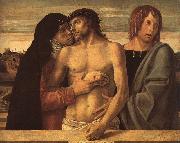

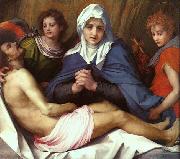
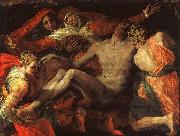
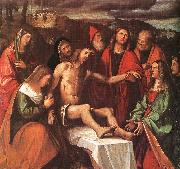
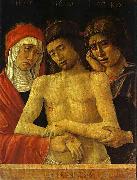
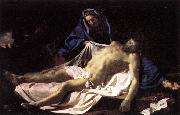

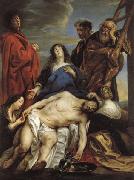
-274782.jpg)
